Relief elastic is a type of pattern, performed with knitting needles of a smaller diameter than recommended by the manufacturer for a given yarn, using a complex combination of various types of loops with yarns.
This group includes French, Polish, Bulgarian and other elastic bands, which differ in patterns and are used to create warm, voluminous items from woolen yarn, and to decorate necklines or sleeves.
What is needed for work
Relief elastic is used when knitting men's, women's and children's clothes, it decorates the bottom of the product, but it requires increased yarn consumption due to the periodic yarn overs and removal of loops.
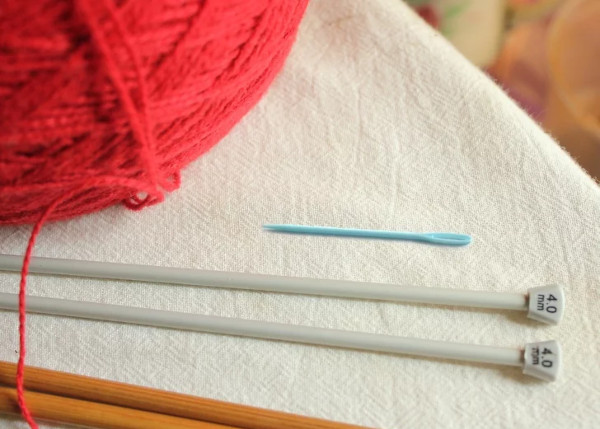
Materials required for work:
| Threads | It is recommended to use only high-quality thick yarn for knitting, made from merino wool, alpaca of various colors, with the obligatory addition of synthetic fiber (nylon or polyamide). This is done so that the finished product does not lose its original properties for a long time, and also stretches well. Suitable yarn for work:
|
| Spokes | Beginners can work with both straight and circular knitting needles, selected depending on the type of the selected relief elastic. It is also necessary to take into account one nuance - when purchasing knitting needles of a smaller size than the manufacturer recommends for the selected yarn. You can also fold the thread in half. |
| Additional tools |
|
Scheme of work
The relief elastic knitting (the work scheme assumes the obligatory alternation of different types of loops, as well as the execution of yarns) is distinguished by a good, springy effect, and can be used both for knitting snoods and scarves, and as a main or additional pattern when working on a sweater, vest. Several of its variants are distinguished by professionals.
With loops extended
The pattern is made by initially casting on a number of loops divisible by 3 with the obligatory addition of 2 edge loops (placed at the beginning and end of each row). In addition, when working on the front strip, the yarn between the loops is necessarily pulled out, after which the purl loops are knitted together.
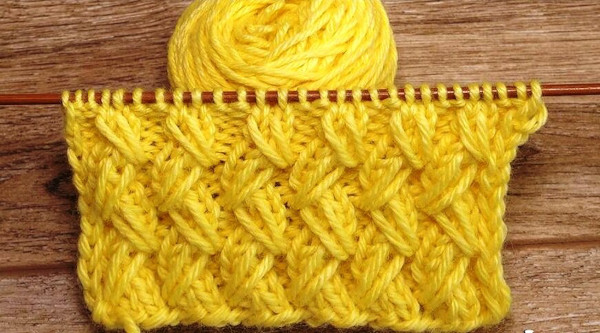
Before starting work on the 2nd row, the knitting will need to be turned over to the other side, with the previously stretched loops becoming the wrong side. In this case, you should remove the edge loop and knit 2 purl together - one of them will become stretched.
You will need to continue in this manner until the end of the row, and then, alternating the rapport of the 1st and 2nd rows in even and odd rows, complete the entire piece of the product.
Pattern "Ear"
The raised pattern "ear of corn" involves working with a total number of loops divisible by 5 (to which are added 1 loop providing symmetry and 2 edge loops).
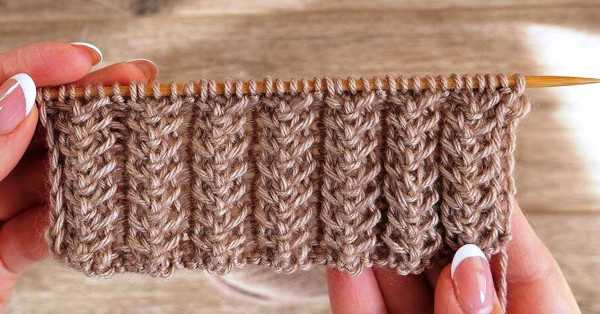
Drawing diagram:
| 1st row (front part) | A repeating pattern of 1 purl + 1 knit stitch, then skip 2 stitches, pick up one and knit them. The new stitch should be dropped onto the knitted ones and 1 more knit stitch added. The pattern is repeated throughout the entire circle, and at the end of the circle, the purl and edge stitches are placed. |
| 2nd row (wrong side) | A repeating pattern of 1 knit stitch + 2 crossed 1*1 stitches left and right. The circle ends with an edge stitch. |
| Odd circles (3rd, 5th, 7th) | Knit according to the pattern of the 1st row. |
| Even rows (4th, 6th, 8th) | They exactly repeat the rapport of the 2nd circle. |
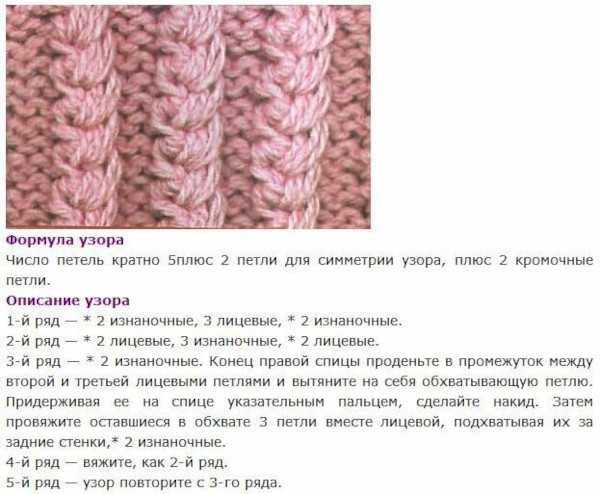
Each row during work should begin and end with edge loops.
Original
The relief elastic, suitable for creating warm oversized items, involves working with the initial set of knitting needles, divided by 3 (with 2 edge loops included). The rapport pattern will vary depending on the complexity of the pattern.
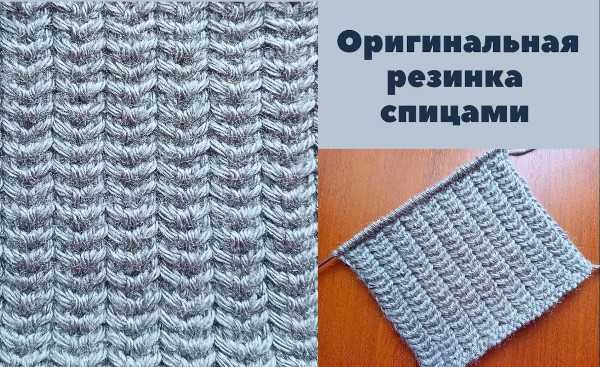
When completing a drawing, you need to:
- in the 1st row - immediately after the edge stitches, place 2 front loops knitted together behind the back wall of the loop + 1 front loop knitted along the back wall in the next 2 loops + 1 back loop.
- in the 2nd round – make a constantly repeating pattern of 2 front loops + a loop removed and transferred to the front half of the knitting.
In subsequent work, alternation of patterns of the 1st circle (in odd rows) and the 2nd circle (in even rows) is assumed. Each of them should be started and finished with edge loops.
American
The relief elastic version, also called “American”, involves knitting stitches with knitting needles in multiples of 3 (taking into account the stitches used for the symmetry of the pattern and the beginning, ending, and edge rows).
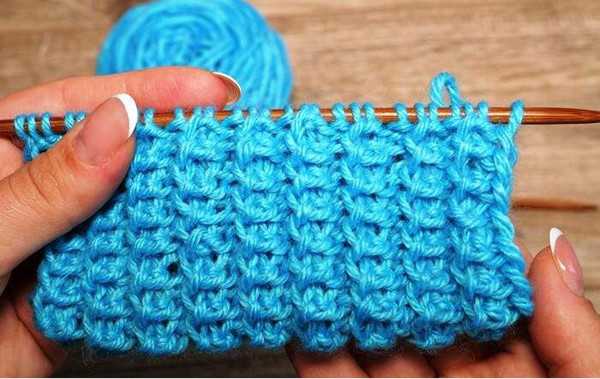
Rapport scheme:
| 1st row (front half) | 2 front loops + 1 back loop. It ends with 2 front loops and an edge loop. |
| 2nd row (wrong side of the product) | Yarn over with 2 knit stitches, after which it is dropped through the knitted stitches. The rapport is completed with a knit stitch. The pattern is repeated until there are only 3 stitches left to complete the row, after which a new yarn over with 2 knit stitches is made and dropped. |
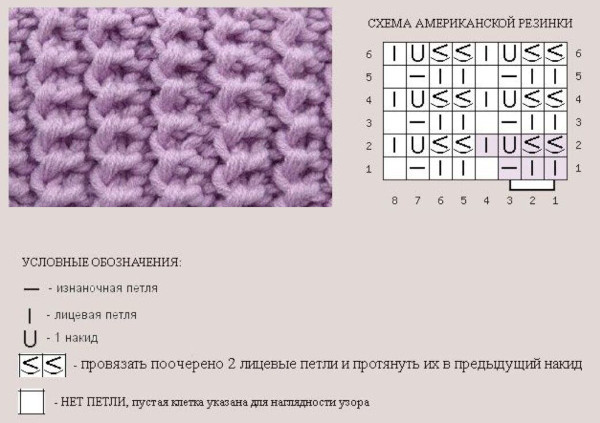
Then the work continues with alternating patterns of the 1st (in 3, 5, 7 and other odd rows) and 2nd (in 4, 6, 8 and other even) rows. They begin and end with edge loops (1 at each end).
From 3 loops
The 3-loop elastic band is made by alternating the pattern of even and odd rows, while the total number of loops in the cast-on row must be a multiple of 3 (with the addition of 2 edge loops).
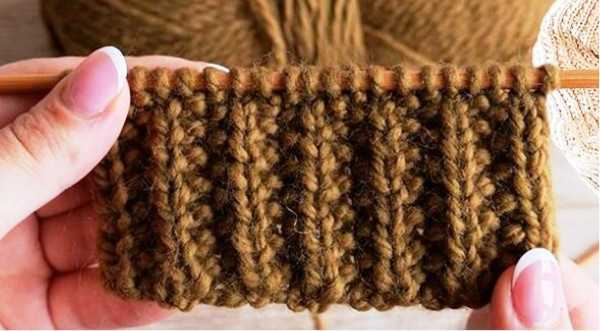
Rapport scheme:
| 1st row | 2 front loops + 1 back loop. The row should be finished with a front loop placed before the edge. |
| 2nd row | 2 purl + 1 knit stitch. The circle ends with a purl stitch. |
| 3rd and odd rows | Performed in the same way as the 1st row. |
| 4th and even circles | Knitted according to the rapport of the 2nd round. |
Each row begins and ends with an edge loop.
Volumetric
A voluminous elastic knitted with knitting needles is suitable for decorating the neck or bottom of a knitted sweater, and to create it you will need to make a set of loops divisible by 6 (it includes 2 loops that ensure the symmetry of the pattern and 2 edge loops, the beginning and ending row).
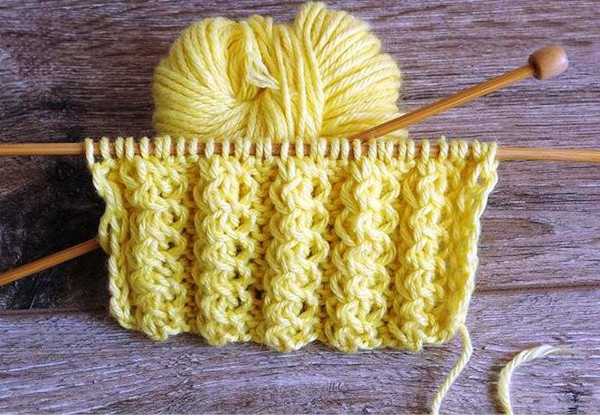
Rapport:
| 1st (front) circle | Make a pattern of 2 purl, crossed 2*2 to the left, loops. |
| 2nd (purl) row | Knit a pattern of 2 front loops + 3 knitted together purl loops + yarn over with 3 knitted together purl loops all around the circle. It needs to be removed by passing it through the knitted loops. |
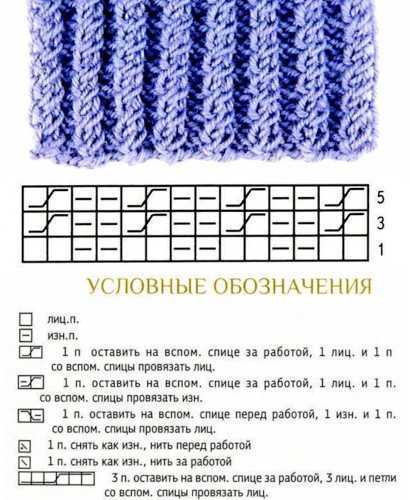
Next, work on the collar, sleeves or bottom of the product continues with alternating patterns of the front (in odd) and back (in even) circles. Their exact number will depend on the size of the product (5-18), with an edge loop placed at the beginning and end of each.
With oblique loops
To create a pattern with oblique loops, you will need to cast on any odd number of loops (including edge loops) on the knitting needles, and then first complete 2 basic rows with a simple 1*1 elastic band (front + back loops), and then move on to knitting according to the pattern, while:
- In the 3rd row, after the edge loop, performing a rapport, for which, having skipped the first loop, insert the right knitting needle into the second loop of the previous row from the bottom, pull it out onto the right knitting needle, make a yarn over and knit it together with the front one with the working knitting needle. The row is completed with a front and edge loop.
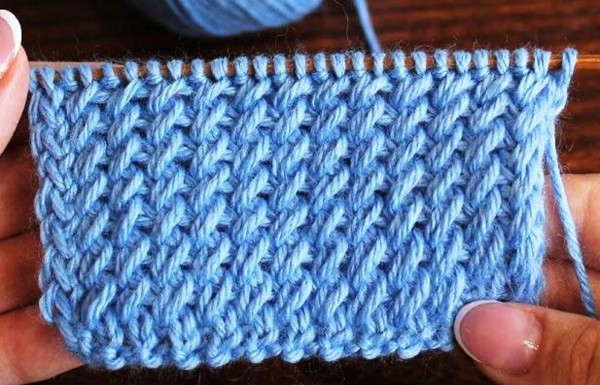
- Row 4 – start with the edge stitch, then knit a pattern of 2 purl stitches and one knit stitch joined together. The purl stitch placed before the edge stitch will be used to complete the circle.
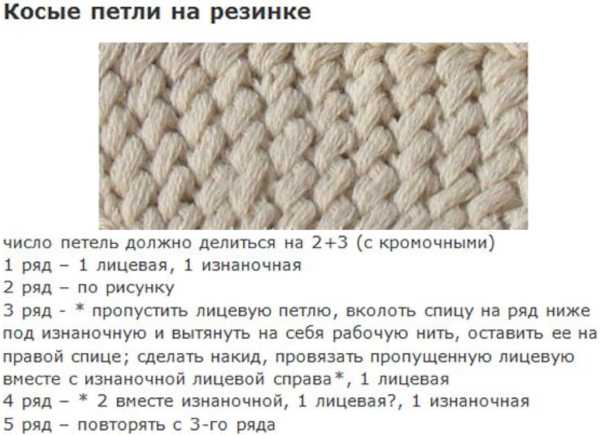
- Subsequent work on the pattern involves alternating the rapport of the 3rd and 4th circles in even and odd rows. It is performed when the product reaches the required length.
Hollow
Hollow relief elastic is knitted with any number of loops (it does not matter, even or odd), and after working on the first row it will automatically increase by 2 times. It is also recommended to deliberately reduce the calculated number of cast-on loops by 2 times, after which they will need to be connected in a circle and knitted according to the pattern.

Pattern drawing:
| 1st row | 1 knit stitch with a yarn over. |
| 2nd round | A stitch removed from the working needle and a yarn over, knitted with purl stitches. |
| 3rd row | 1 knit stitch and slip stitch transferred to the front side (yarn in front of work). |
| 4th row | Loop removed on the wrong side (thread behind work) + additional purl loop. |
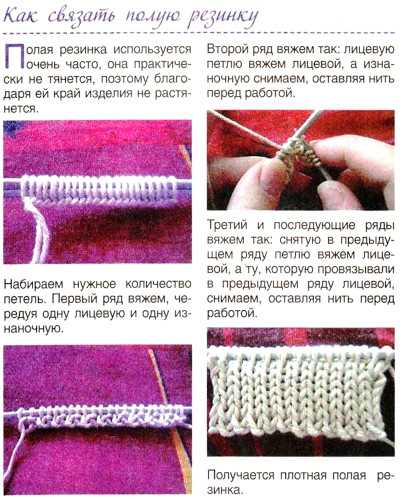
To form the pattern, further work is carried out with constant alternation of the rapport from the 3rd and 4th rows.
One-sided
Relief elastic knitting (a knitting pattern that involves a constant change of pattern, suitable for knitting simple scarves, snoods and hats), also called “one-sided”, involves an initial set of loops in multiples of 5 (+2 edge loops and 4 loops that ensure the symmetry of the pattern).
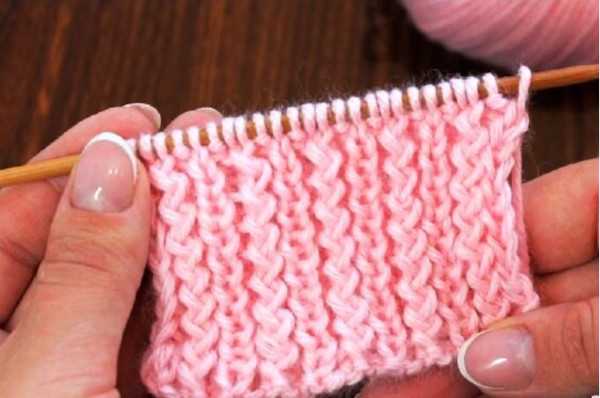
Work scheme:
- 1st "front" row (repeating rapport): 1 purl + 2 crossed front loops + 1 purl + 1 front loop. It is knitted up to 10-11 times, and the row is completed with: 1 purl + 2 crossed front loops + 1 purl loop.
- 2nd “purl” row (pattern repeated 7-8 times throughout the row) 1 front + 2 crossed back + 1 front + 1 back loop. The row ends with 1 front + 2 crossed back + 1 front loop.
- 3rd and odd rows - knit according to the pattern of the 1st row.
- 4th and even rows - must exactly repeat the rapport of the 2nd circle.
Zigzag
The relief elastic knitting pattern (the pattern diagram must necessarily include the beginning and ending edge loops of the row) "zigzag" is suitable for decorating women's sweaters and vests, as well as knitting children's clothes.
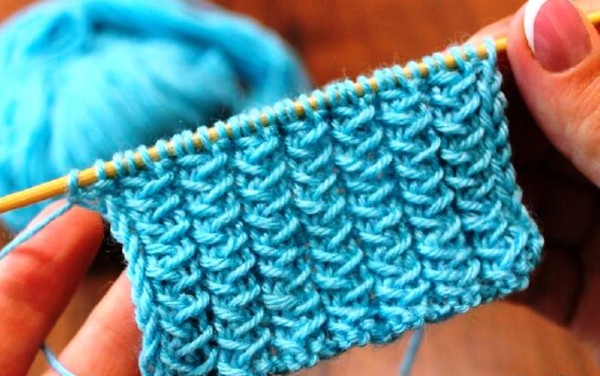
To work on it, you will first need to cast on a number of loops that is easily divisible by 4 (taking into account the edge loops and the loops used for symmetry).
Rapport located between edge loops:
| 1st row | 1-on purl + 1-on front loop, removed onto the working thread + 1-on front loop with a yarn over, thrown over the knitted loops. The row is completed by placing a purl loop in front of the edge. |
| 2nd round | 1-on the front + purl loop slipped to the front side + 1-on the back loop with a yarn over, thrown over the knitted loops. The circle is completed with a front loop. |
| 3rd and odd rows | Performed exactly the same as the 1st circle. |
| 4th and even rows | Continue the rapport of the 2nd circle. |
With loops wrapped around it
The rapport of the relief elastic with wrapped loops consists of 4 rows, and work on the pattern begins with a set row of loops, divisible by 4 (taking into account 2 edge loops and loops used for symmetry).
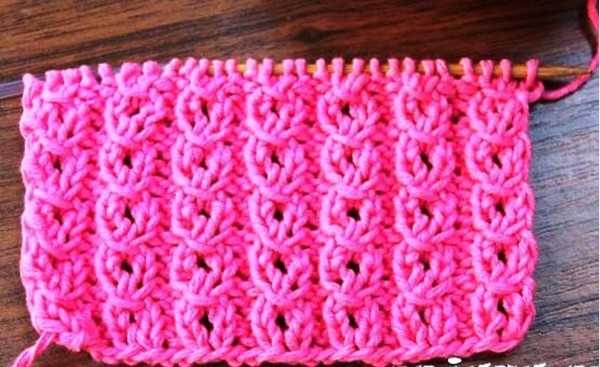
The pattern is located between the edge loops placed at the beginning and end of the row and consists of:
- 1st (front row), which includes a front loop with a yarn over, after which 1 front and 2 back loops are made. The pattern is repeated 7-8 times (up to the last 3 loops), and then, in order to complete the row, 2 front loops are knitted, separated by a yarn over (1 + yarn over + 1).
- 2nd (wrong side) circle, including 3 purl + 2 front loops. The pattern is performed 7-8 times (up to the last 4 loops), after which the row is completed with 3 purl loops placed in front of the edge.
- 3rd row with 3 front loops, after which the yarn over of the first knitted loop is performed on the last 2 and 2 following purl loops. The rapport must be repeated throughout the entire row, and to finish it, perform 3 front loops, with the yarn over of the first loop on the other 2. The edge loop is placed last in the row.
- 4th round - with 2 purl + 2 knit stitches. It ends with purl stitches.

To form a pattern when knitting, you need to repeat the rapport of rows 1-4.
Polish
The relief elastic, also called "Polish", is used for knitting voluminous men's sweaters and hats. Its set row consists of a number of loops that are multiples of 4 + 2 edge loops, and the pattern assumes constant alternation of the pattern of the 1st and 2nd rows.
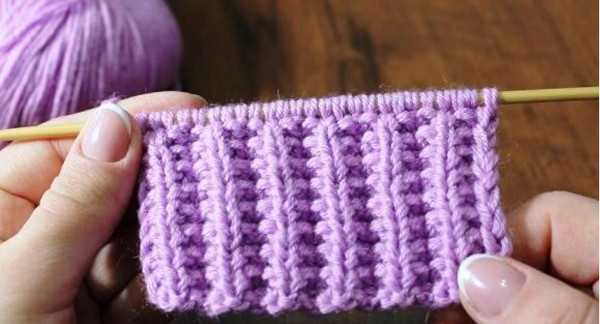
Rapport (located between edge loops):
| 1st row | 1 purl + 3 knit stitches |
| 2nd row | 1 knit + 1 purl + 3 knit stitches. The pattern is knitted until there are only 4 stitches left in the row, after which you need to make 1 purl and 2 knit stitches, placing them before the edge stitch. |
Each row begins and ends with edge loops.
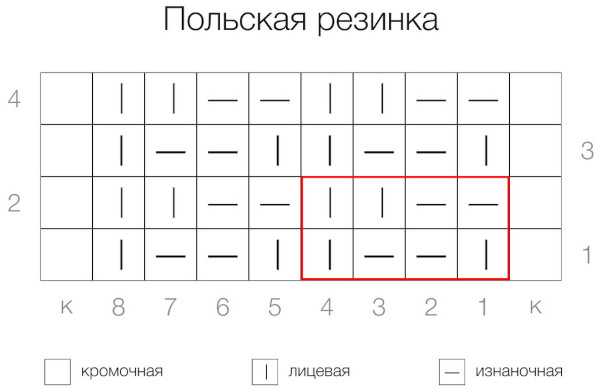
When working on a men's sweater, using a relief "Polish" elastic band, it must be additionally connected with a simple 1*1 elastic band.
Double-sided
Double-sided relief elastic is most often used when knitting warm scarves and involves a set of loops that are easily divided into 6 + symmetrical and 2 edge loops.
Pattern repeat:
| 1st row | 1 knit + 1 purl + 1 knit stitch. |
| 2nd row | 2 knit stitches + 3 purl stitches + 3 knit stitches. The row ends with 3 purl stitches and 2 knit stitches + edge stitch. |

Subsequent knitting involves constant alternation of the rapport of the 1st row in odd and the 2nd row in even circles, until the fabric reaches the desired size, and they always begin and end with edge loops.
Tips and tricks
When knitting with a relief elastic band, regardless of its type, experienced craftsmen advise beginners:
- Use only thick wool threads of good quality, which will make the finished product voluminous, and also prevent possible discomfort when wearing. After the work is completed, the resulting model can also be hand washed in warm water with a small amount of fabric softener, and then rinsed. This is done in order to fluff up the yarn and make it softer.
- When knitting, use straight or circular needles made of wood or bamboo one size smaller than recommended for the yarn, which will make the pattern more expressive and voluminous. You can also fold the thread in half when knitting.
- It is essential to use a marker in your work, marking the end of a row with it, as well as a notebook (or a workbook), where all increases, decreases, the work pattern and the type of yarn chosen should be noted.
Relief elastic is a popular type of pattern used to create warm items - hats, scarves, snoods and oversized sweaters. The types of pattern differ in patterns and knitting complexity, but despite this, they all require the use of only high-quality wool yarn and smaller knitting needles, which are responsible for the relief and volume of the finished product.
Video about knitted ribbing
Knitting a beautiful relief elastic band with knitting needles:
